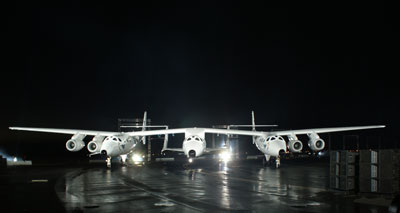Celebrate suborbitalby S. Alan Stern
|
| NASA and the Obama Administration are to be commended for their farsighted thinking in encouraging and funding the development of suborbital applications beyond tourism. |
Late last month almost 300 participants—far more than initially anticipated—gathered at their own expense in Boulder, Colorado for the Next-Generation Suborbital Researchers Conference. The conference—the first of its kind for this new type of human spaceflight—demonstrated the powerful draw of this new American industry for something far beyond its space tourism roots for scientific and engineering research, technology development and educational applications.
At that conference, NASA Deputy Administrator Lori Garver surprised and delighted the assembly by announcing a $75-million, five-year effort proposed in President Obama’s NASA FY2011 budget for the development and flight of NASA-funded experiments and (once vehicle safety certifications satisfy NASA requirements) hopefully experimenters and educators, too.
NASA and the Obama Administration are to be commended for their farsighted thinking in encouraging and funding the development of suborbital applications beyond tourism, and putting the United States at the forefront of what many expect to become a worldwide activity. In doing so, they are opening up a host of exciting new possibilities for a diversity of fields, including aerodynamics, microgravity sciences, space life sciences, upper atmospheric research, education, and public outreach.
Now, with both the advent of suborbital capabilities and funding for research and education applications, NASA’s next-generation suborbital efforts also offer an important new capability to routinely and inexpensively develop, test, and screen payloads and technologies before they fly to the International Space Station.
Encouraging the development of reusable suborbital spacecraft lines that fly at expected rates of dozens to hundreds of flights per year, depending on the manufacturer, will also yield important operational experience for future reusable orbital transportation systems. Moreover, because commercial suborbital vehicles promise the first large-scale public access to spaceflight, they will undoubtedly increase excitement about space travel—something that I suspect will dramatically increase public support for NASA’s human spaceflight program.
As this year and next unfold, it is expected that at least two and perhaps as many as four “next-gen” reusable suborbital spacecraft will begin test flights to space and back. Never before in the half-century long history of human spaceflight has such a rich diversity of flight systems been in use.
| In this, there are the seeds of a revolution in human spaceflight with strong analogies to the revolution in computing that occurred when mainframes were supplemented with personal computers. |
And during 2010 and 2011 it is my hope that NASA and the Administration will take still longer strides and bolder steps to further exploit the great start they have made in fostering the domestic suborbital spaceflight industry. Three specific steps come to mind, each of which offer to amplify the impact of this new and very 21st century American industry, and the space access capabilities it offers:
Encourage other federal agencies, such as NIH, NSF, DoD, NOAA, and USGS to also leverage the new suborbital capabilities coming on line to better serve their communities and missions.
Encourage foreign space agencies to also invest in suborbital applications—flying their own crew and payloads. Such a move could quickly and easily advance NASA’s ambitions to internationalize human spaceflight and to further interest in farther flung cooperative endeavors for ISS exploitation and even exploration of the Moon, asteroids, and planets.
Streamline and accelerate efforts within NASA to authorize the flight of NASA and NASA-sponsored personnel on suborbital missions, thereby further increasing public interest in human spaceflight and creating a space economy where public participation becomes increasingly safe and increasingly ubiquitous.
As a scientist, as an aerospace executive, as a former NASA manager, and as an American, I am excited about the new era of frequent, low-cost suborbital access to space for people and payloads. Hundreds of tourists and now hundreds of researchers and educators have expressed their interest in suborbital spaceflight. In this, there are the seeds of a revolution in human spaceflight with strong analogies to the revolution in computing that occurred when mainframes were supplemented with personal computers.
We are truly standing on the threshold of a renaissance for human spaceflight. Join me in celebrating the promise of suborbital spaceflight by urging the Congress to fully fund commercial suborbital research in NASA’s budget proposal for FY 2011. And join me in further encouraging NASA and other federal agencies to fully utilize the burgeoning suborbital industry and the revolutionary capabilities it offers to expand space access, research, education, and commerce.
